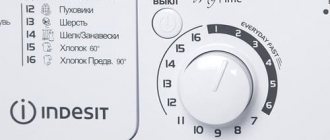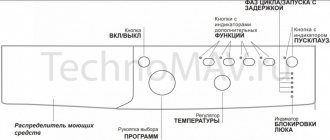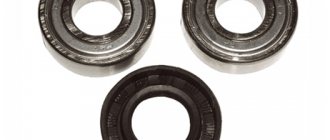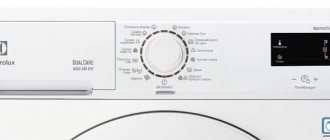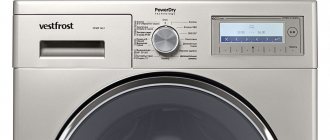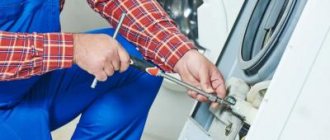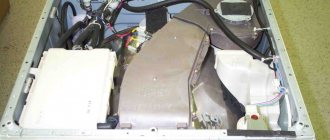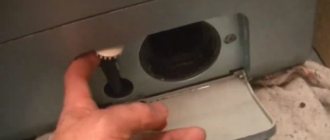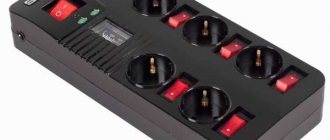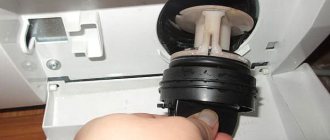The washing machine, which is an assistant to every housewife, is certainly a complex mechanism. It is filled with various parts that power the entire unit. But any equipment, even the most reliable, will eventually fail. To repair the device, you need to know what parts are inside and how to replace them. One of the main components of the washing unit are bearings. As soon as they fail, the washing machine begins to make very unpleasant and rather loud sounds when spinning. To eliminate the breakdown, it is necessary to replace it, and for this you need to know which bearing is on the drum of the washing machine.
Bearing in drum
How does a bearing unit work?
This important mechanism is the connecting link between the drum and the pulley of any automatic machine, which provides the former with rotation during the washing process. Therefore, the functioning of the device itself depends on its correct operation. In most SMAs, bearings are installed in a special cross, which is mounted on the drum, or rather on its rear wall.
The subassembly itself is represented by two types of elements:
- Internal. More powerful (thicker and larger in diameter), since it takes on a larger load. It is located near the drum itself.
- External. Located at the other end of the shaft. It plays a secondary role, therefore it is significantly smaller in size than its “colleague”.
In some washing machines you can see double-row mono bearings. They consist of two rows of balls for rotating the shaft, and not one, as is usually the case.
In this case, instead of two single-row elements, one double-row is used.
An important element in the operation of the mechanism is the oil seal (rubber sealing ring), which tightly covers the shaft and prevents water from leaking through it.
If the seal is worn out, it will definitely leak water from the tank, therefore, failure of the mechanism cannot be avoided. If the oil seal is intact, then when replacing the unit it must be lubricated.
Causes of wear
Bearings begin to wear out as soon as the seal is damaged. This element in the design plays a protective role, protecting the bearings from interaction with water. If the oil seal is damaged, water begins to leak out, the lubricant is washed out and the most important working unit of the machine suffers. If you do not replace it in a timely manner, you will have to change the drum in the future, which is very expensive.
Many users ask the question: why do bearings become unusable? Experts say that even in such high-quality and reliable units as Indesit, Bosch, Ariston, Samsung, natural wear occurs after 6-7 years of operation. If the breakdown occurred earlier, it is likely that the equipment was not operated correctly and was often overloaded.
What types of bearings are there?
Workmanship and manufacturer are important attributes. But one factory may have two model ranges that are equally suitable for the same washing machine.
In particular, the clips differ:
- Metal (ZZ) is the cheapest and simplest in terms of technology, sometimes it allows you to push in more lubricant with a needle and syringe.
- Plastic (2RS) – better protects against dust, often harder to lubricate.
Differences in protection density, base, materials are possible. Rubber, plastic, and metal strips are used. The cage and separator, the balls themselves, can have a special hardening technology and have different profiles.
As a rule, two bearings are used. Small and big. They are designated by numbers, for example 6204/6305. Some models also have one long bearing.
There are two ways to find out bearing numbers. The best way is to disassemble the machine, remove the drum, press out the old bearings and find new ones based on the markings or sizes. This allows you to find exactly what you need, because sometimes minor upgrades were carried out at factories during the year, for example, crosses, drums, and so on were changed.
The second option is to look at the serial number of the washer or model in the tables. There are plenty of them on the Internet. It happens that bearing numbers are also given in the instruction manual.
Bearing replacement
The procedure is time-consuming, but if you have basic repair skills, you can handle it without calling a specialist. It is necessary to dismantle the top, rear and front walls. Then you need to disconnect the hoses from the tank, the sensor connectors, the power wires of the heating element and the motor (with direct drive).
After this, the counterweight mounts (heavy cement structures) are unscrewed and the shock absorber springs are removed.
The tank is removed from the machine, and you get full access to the bearings.
As a rule, it is necessary to disassemble the tank into two halves. Then assemble it using sealant. Removal and re-seating of bearings is carried out using special pullers and mandrels, similar to servicing a car.
If you do not have such devices in your arsenal of home tools (and therefore have no experience in such work), we recommend that you contact a workshop. The operation of replacing a bearing seems simple for experienced car enthusiasts.
How to choose a bearing
To replace a worn-out part, the main question will be how to find out what bearing number is needed for a specific SMA model.
It is not possible to buy a universal spare part, since the size range of units is very large. Even one manufacturer of washing machines can have up to a dozen different sizes.
There are three options here:
- Look in the instructions for the device, where the manufacturer must indicate this data.
- Search for the necessary information on the Internet using the serial number of the washing machine.
- Remove the old assembly and look at its markings.
The third option is the most reliable, since the removed element can be used as a sample for selecting a spare part similar to it.
You can choose the right option based on what size range the SMA manufacturer prefers to use:
- In washing machines of the LG and Bosch brands, the following codes are most often found: 6203, 6204, 6205, 6206, sometimes 6305 and 6306 (all marked ZZ).
- Samsung SMA most often uses parts of type 6203 and 6204, sometimes 6205 and 6206.
- For Beko brand SMA, only codes ZZ 6203, 6204 and 6205 are suitable.
- Atlant washing machines are limited to only two codes: 6204 and 6205.
- Washing machines of the Ariston brand mainly use monobearings marked BA2B 306037 of the famous Swedish brand SKF. In other cases, codes from 6203 to 6206 marked ZZ are suitable.
- Vestel and Zanussi washing machines are suitable for sizes 6203 and 6204.
- On Indesit brand machines, parts of size 6204 or 6205 are installed, less often 6203.
This list is for informational purposes only, since the manufacturer may make changes to the configuration at its discretion. Therefore, we recommend choosing the size based on the specific SMA model.
Let's look at the popular types of single row bearings
A unified classification standard is not limited to washing machines, which makes it easier to select replacement components. Household appliances use markings consisting of 4 numbers and letter combinations. For example, 6203Z (ZZ). The letter at the end of the abbreviation means that the bearing is completely metal, low noise. The numbers themselves have no relation to the physical size; the actual mounting diameters (internal and external), as well as the width of the cage, are determined from the table.
Important: The bearing width is the same for the inner and outer ring, so the table shows only 3 dimensions.
A similar classification is provided for double-row bearings. The marking of the unit for your machine can be found in the technical documentation, although not all manufacturers indicate this parameter, assuming that the repairs will be carried out in specialized workshops. If the information is not freely available, you will be able to see the markings after dismantling the tank and drum. You will still have to disassemble the machine to replace it.
Signs of bearing failure
- Grinding noise when the drum rotates. If you have a direct drive washing machine (the motor is mounted on a drum), it is the support bearing that makes the noise. Accurate diagnostics on machines with an external drive are only possible after removing the belt drive. A similar sound can be produced by an external motor that also has bearings.
- The drum rotates with difficulty (check with your hands, when turned off). For an external drive, remove the belt again.
- Strong vibrations when rotating at high speeds. To check, you need to run the spin mode with an empty drum.
External inspection for bearing burning (traces of tarnish on the metal), or lubricant leaks, is possible only after complete disassembly of the unit.
Which brand of bearings is preferable to use?
The following manufacturers are considered the most reliable:
- CX (Poland), the bearing blocks of which are the most universal.
- SKF (Sweden). Their products are used by the brands Ariston and Indesit.
- EBI (Italy). This brand is preferred by Whirlpool, Bosch, and Bauknecht.
Before buying a new part, remember that the entire assembly must be replaced, preferably together with the rubber seal. After all, if the oil seal is not replaced with a new one, there is a risk that the repair will be a waste of your time and money.
Well, for those who decided to replace the bearing assembly themselves, we recommend watching this video:
Exploitation
In this process, the shaft may have regular contact with the inside of the product. If the friction does not decrease, the seal for the washing machine will deteriorate and will be able to leak water.
Remember!
It is needed to improve the functional properties of the product. The lubricant can protect the oil seal from wear and cracks. To prevent excess liquid from penetrating oil seals and bearings for washing machines, it is necessary to lubricate them.
To choose a lubricant, pay attention to such points as:
- level of moisture resistance;
- there are no aggressive components;
- high degree of resistance to temperature changes;
- high quality saturation.
Today there are a large number of types of lubricants. Most often, people buy Hydra-2 lubricant.
It comes in two types:
- Hydra Huskey Lube-o-Sela;
- Hydra (regular version).
Bearings for repairing washing machines: markings, sizes, manufacturers
- Signs and causes of bearing unit failure
- Dimensions, markings, characteristics of bearings
- Bearing manufacturers
- Table of repair kits for popular brands
The bearing assembly is located between the drum and the pulley and consists of a shaft (crosspiece), bearings and an o-ring. Main purpose: ensuring rotation of the washing machine drum.
In this article we consider bearings for front-loading washing machine models only!
The drum is usually supported by two single row deep groove ball bearings (different sizes). A large bearing is placed near the drum and takes on the main load. It is protected from water/moisture by a seal (oil seal). Some AEG, Zanussi, Electrolux, Ariston models have one double-row bearing and one oil seal. This type can withstand higher rpm.
If the entire assembly is not replaced in time, “jamming” may occur. In this case, it is necessary to change not only the repair kit, but also the crosspiece or drum.
Putting on a new bearing
After removing the parts from the washing machine motor, you can begin installing new ones. The new item must be 100% identical to the part you are replacing.
During installation, be careful to ensure that no dirt gets inside the bearing. Also inspect even a new element for integrity. No one has canceled the marriage - there may be chips or corrosion of the metal inside.
- Install the part using a small diameter metal pin.
- Before installation, it is recommended to lubricate the part with lubricant.
- Make sure there are no distortions, so hit exactly in the center of the pin, placing it in different places.
- To speed up the process, you can dip the bearing in boiling oil for 5-10 minutes. Remove the part using a hook or pliers. Do not work with unprotected hands!
Bearing grease
The performance of the SMA will depend on the type of lubrication used when installing the bearing. You need to choose a thick, consistent lubricant.
If the engine speed does not exceed 3 thousand in 1 minute, you can use Litol 24 or Ciatim 201. If the engine operates at high speeds, choose a second lubricant, but marked 202.
It is necessary to fill more than half of the bearing chamber with lubricant. For high-speed ones, one third will be enough - if you put more, excess lubricant will still be squeezed out during rotation.
Now you know how to change the electric motor bearings if your washing machine requires it.
Source
How to access the tank
Before removing the bearing on an LG washing machine, you need to disassemble almost the entire machine, gaining access to the tank and drum. Walls, motor, cuff and other parts block your path. How can I quickly remove all this in order to remove the tank and find the bearings?
Step 1: Top cover
- To remove the top panel, unscrew the 2 screws holding the cover on the back of the case.
- Pull the panel towards you.
- Lift up slightly and remove.
- Set the lid aside.
Step 2: Control panel with display or indicators
- Remove the detergent receptacle by pressing the central valve at the back of the cuvette.
- In the niche where the receiver was, find the mount.
- A few more bolts are located at the top and right of the control panel. Unscrew all fasteners.
- Carefully remove the wires from the panel connecting it to the parts of the CM. In order not to forget how everything happened, film the disassembly process on video or label the wiring. If you are a careful craftsman, you don’t have to remove the wires - in this case, work carefully so as not to break anything.
Article on the topic: How to use the Zanussi aquacycle 800 washing machine
Step 3: Bottom panel
- The panel is held in place by plastic latches - find them and bend them back using a slotted screwdriver.
- Remove the panel and set aside.
Action 4. Hatch cuff
Without this, you will not be able to remove the front panel.
- Find the thin metal wire clamp that holds the cuff, pry it with a screwdriver and remove it.
- Pull the cuff out of the groove with your hands without removing it completely.
- Disable the blocker sensor.
- Unscrew the bolts to remove the sensor.
Step 5. Front panel
- The front wall fastenings are located behind the powder receiver, behind the water drain valve and in the corners: upper left and upper right, lower right and behind the display panel.
- Unscrew all the screws found.
- Remove the front cover.
- Set aside.
Action 6. Freeing the tank from fasteners
- water intake valve fasteners;
- water drain pipe;
- wiring from the heating element and temperature sensor;
- wires from the electric motor;
- pump wiring;
- counterweights (large upper and small lower);
- pressure switch pipe;
- shock absorber (damper) fasteners.
Important! After going through the entire list and removing all the wires and pipes, you can remove the tank. Ask someone to help you to make your work easier. Let your partner unhook the springs while you lift the tank and remove it from the housing.
How much does a master's work cost?
If you cannot cope with replacing the bearing on your own, you should contact a specialist. You can find a specialist by looking at an ad in a newspaper or on the Internet. Another option is to contact a service center. If the machine is under warranty, the repairs must be paid for by the manufacturer of the household appliance.
To minimize the risk of encountering scammers, you need to contact trusted professionals or large service centers with a positive reputation. You also need to check with a specialist in advance how much the repair will cost.
How to check bearings
Replacing bearings in a washing machine motor begins with checking them. If wear and tear is not noticed in time (noise in the operation of the automatic transmission system), then in the most severe case the result will be as follows: during rotation, the moving and immovable parts of the engine will begin to come into contact, which will lead to breakdown of the entire engine.
- Place the electric motor on a flat and hard surface.
- Hold the engine with one hand and rotate the shaft with the other.
- If everything is normal, then the rotor will spin smoothly, without snagging.
- If the bearings have served their purpose, you will hear scratching sounds or notice that there is an imbalance when the rotor rotates.
Backlash: how to check
Axial or radial play is an absolutely normal phenomenon, typical even for new parts. It is only important that the backlash is not too large.
Check radial play:
- Place the motor on a flat, hard surface.
- Grasp the shaft with your hand and swing it.
- Only slight deviation is acceptable.
- The displacement indicator is directly proportional to the size of the motor. In a household washing machine engine, these offsets can be subtle.
- Grab the shaft and pull the rotor toward you or push it away from you.
- A deviation in the SM engine of more than 0.3 cm already indicates a problem.
If, while disassembling the motor, you find traces of friction between the rotor and stator, then this already indicates that the engine requires repair, or rather, bearing replacement. If the rotor is worn out, then this element must also be replaced.

